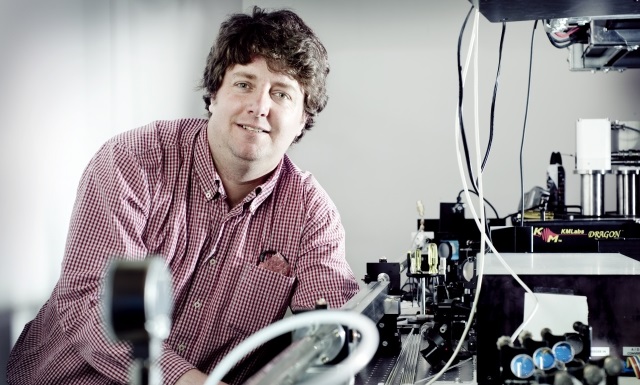May 13, 2014
By Stéphanie Thibault
Going back to the drawing board to find a way to overcome the technical limitations of their laser, a team led by François Légaré, professor at the INRS Énergie Matériaux Télécommunications Research Centre, developed a new concept offering a simpler laser design, control over new parameters, and excellent performance potential. Called “frequency domain optical parametric amplification” (FOPA), the concept supersedes traditional time domain amplification schemes that have been the linchpin of ultrafast laser science for 20 years. The new concept is explained in detail in an open access article in Nature Communications.
For researchers, capturing images of a moving electron is the holy grail of molecular imaging. But in their efforts to generate a light pulse that is sufficiently short and powerful to capture such an image, researchers have been held back by the fundamental limitations and unsatisfactory performance of lasers. “Our goal is to capture images of a chemical reaction using high spatial and temporal resolution,” explained François Légaré, speaking at the TEDxConcordia event. “I want to shoot a video where you can actually see the atoms dancing in a chemical reaction.”
Amplifying laser pulses in the frequency domain rather than the time domain also overcomes certain technical constraints, among them the ability to access multiple different frequencies simultaneously and control them independently. In addition, higher light pulse energy can be achieved with the new concept. “Our approach holds promise for high-power, broad spectrum, few-cycle laser sources,” said the young researcher.
In the proof of concept presented in the Nature Communications article, Professor Légaré’s team demonstrated that FOPA generates pulses comparable to lasers using time domain amplification in the given conditions: 1.5 mJ, 1.8 microns, 12 fs duration corresponding to 2 optical cycles. Research associate and lead author Bruno Schmidt points out that not only does the FOPA approach open up access to parameters that could not previously be controlled, it also eliminates many complex assembly components. “The logic underpinning this concept could be applied to other types of applications,” he added, “so we believe it will allow us to look at nonlinear optics in a whole new light.” Optimistic and ambitious, Bruno Schmidt plans to market the innovations stemming from his work, even founding his own company, few-cycle Inc.












